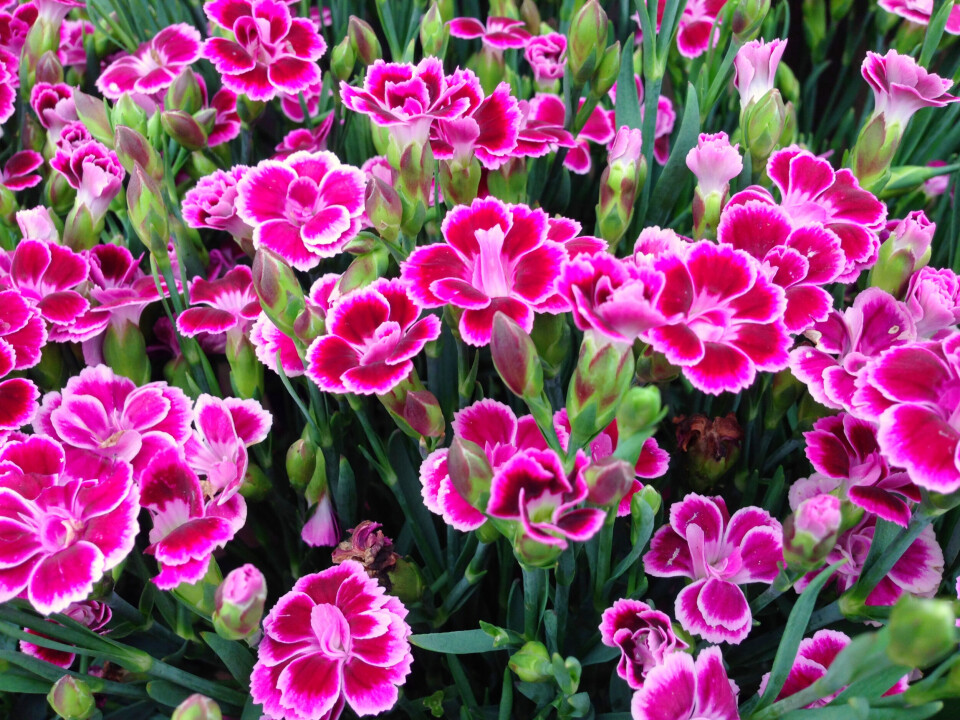-
Let your lawn grow, water for birds: how to help wildlife in your French garden
‘It is acceptable to have untidy hedgerows,’ says biodiversity spokesperson.
-
How to help hedgehogs in your garden in France
Follow these tips to create a healthy ecosystem for this protected species
-
How to pick and cook asparagus in France
Columnist Sue Adams explains how to make the most of the vegetable's short season
Gardening in France: Dianthus or pinks are a classic passalong cutting
Cathy Thompson looks at the history of gillyflowers and how to take cuttings to keep up the ‘passalong’ tradition

Passalong plants are a firmly established tradition, although it seems that American gardeners first coined the term.
We’ve all been doing it for centuries – trawling the surrounding countryside for the beautiful and the useful – and then passing along our treasures to friends and fellow gardeners.
Shakespeare was writing at a crossroads in horticultural history and reflects both the older medieval wildling/passalong culture and the hint of the new wave of alien and hybridised plants beginning to be introduced in the sixteenth century.
In The Winter’s Tale (Act IV. Scene iv), he puts a contemporary debate into Perdita’s mouth, using the garden-worthy genus Dianthus as an example:
‘… our carnations and streaked gillyvors,
Which some call nature’s bastards. Of that kind
Our rustic garden’s barren, and I care not to get slips of them.’
In a spooky echo of twenty-first century controversy, Perdita and Polixenes are arguing about the rights and wrongs of ‘meddling’ with nature and Perdita is turning her nose up at taking ‘slips’ (heeled cuttings) of the modern, ‘messed with’ garden pink (gillyflower), believing that the native, ‘pure’ forms are best.
A cure for the plague
The garden pinks, primarily bred from Dianthus plumarius, were probably amongst the most experimentally hybridised garden plants in Shakespeare’s day – and also amongst the most precious ‘passalongs’.
Their popularity exploded during the fifteenth and sixteenth centuries and they were increasingly featured on fabrics, home furnishings and books of hours, symbolising fidelity and strength in a union of love.
More practically, it has been suggested that one cause of the great upsurge in their cultivation was the prevalence of plague in Shakespeare’s time: the roots of gillyflowers were believed to provide a rare remedy.
Origins of name
But when ‘pinks’ first became the rage, there was no word for the colour pink in English at all, in fact the colour was named for the flower.
There are two theories of how the flower itself was named. The first is that they took their name from the appearance of a new verb, first in vogue in the fourteenth century: to ‘pink’ meant ‘to decorate with a punched or perforated pattern’ and there’s not a huge imaginative leap to associate the decorative effect with the flower.
More prosaically – but because of that probably truer! – pinks may have been named after the Dutch word for Pentecost (‘pinksteren’), because they begin to flower in late May.
I like Perdita’s use of the old word ‘gillyflower’, presumed to have arisen from an association between the rich clove scent of the old pink varieties and the Italian (girofano) or French (girofle) word for clove.
Used to spice wine
Ever practical and open to suggestion, the English were already busy dunking pinks in their favourite mulled wines by Shakespeare’s day, presumably to intensify the clove scent of the beverage (and perhaps to ward off plague?).
So much so, that they had begun to call the flowers ‘sops-in-wine’.
‘Sops-in-Wine’ is itself a famous old medieval century cultivar that perfectly expresses the preferred characteristics of that era: good clove scent, and a decorative lacing of wine red on a white background.
Few French cultivars remain
However, like all ‘passalongs’, it is as varied in its modern appearance in horticultural commerce as if one was playing a game of Chinese Whispers!
But this is the type of flower – the one that we see as ‘old-fashioned’ – that was the up-and coming thing in Perdita’s day – the sort of ‘man-made’ flower she was turning her back on.
What the British and Americans know as ‘border’ or ‘garden’ pinks, the French call ‘oeillet mignardise’. They were as popular in French gardens as in English, but strangely the old French cultivars have left little trace of their existence and those available in France have mostly been bred in England, to the extent that many are now advertised as ‘oeillet anglais’.
How to take cuttings
Look out for the ‘Scent First’ range from Whetman Pinks and the Allwood hybrids (of which the most famous is probably ‘Doris’), bred by crossing carnations (D. caryophyllus) with the old pinks.
Although not always the easiest plants to propagate, heritage treasures such as eighteenth century ‘Barr’s Red’ or ‘Musgrave’s Pink’, are still with us – testimony to their passalong sturdiness in the right hands.
The modern pinks, in contrast, lend themselves perfectly to the passalong ‘chancer’ armed with secateurs and plastic bag.
Cuttings of about 8 to 10 cm, cut just below a leaf node and inserted into very well-drained compost usually work well.
Heeled cuttings, taken by delicately pulling a side shoot from the main stem with a small piece of protective, slightly woody material that acts as a barrier against rot, are even better.
Continue the passalong tradition
But ask politely first – and don’t ever thank the donor.
Apparently there’s an American tradition that all your plants will rot and die if you show gratitude for a passalong!
You must simply promise to love and treasure.
Bringing me neatly to my conclusion.
Passalongs (whether pink or any other hue) should come with a health warning.
They are often passalongs because people have too much and are trying to get rid of them.
I was once stupid enough to accept – joyfully – small pieces of variegated lemon balm (Melissa officinalis).
At that stage I had never heard it described as ‘the herb from hell’. Oh yes!
What are your favourite passalongs – and why? Email editor@connexionfrance.com
Related articles
Five drought management tips for gardens from a French plant expert
Traps placed to stop damaging Japanese scarab beetle coming to France
Donations from open garden scheme fund gardens in 60 French hospitals
























